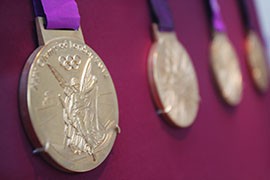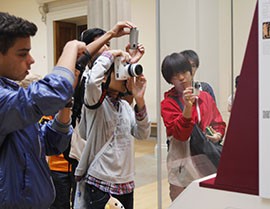Cronkite News has moved to a new home at cronkitenews.azpbs.org. Use this site to search archives from 2011 to May 2015. You can search the new site for current stories.
Museum gives fans an up-close look at London Olympic medals
LONDON – For ancient Olympians, competing in the games was about bringing home the green, not the gold. Early winners received crowns of olive leaves, not precious metals, as symbols of success.
Whatever the time period, winning in the Olympics has always been a source of patriotism, and athletes wear their prizes proudly.
This year, the British Museum is giving London residents and Olympic spectators a close-up look at the 2012 Olympic and Paralympic medals. The “Mine to Medal” display is part of the London 2012 Cultural Olympiad.
The exhibit tells the story of the medals from mining to final design and production. It also provides the history of Olympic medals and features victory and commemorative medals from the 1908 and 1948 London Games.
To establish the 2012 London Olympics medals, arts organizations throughout Britain nominated artists to submit designs to the London Organizing Committee. Then a jury of experts selected the two winners: jewelers David Watkins and Lin Cheung, respectively, for the Olympic and Paralympic medals.
In Watkins’ design, the back of the Olympic medal features symbols he said represent “the spirit of the games and the city of London,” according to the exhibit. The London 2012 logo and the River Thames, representing a finish line, are prominently featured. Lines scattering outward symbolize the “activity generated by the Games.”
The front of the medal, featuring the goddess Nike, is a reworked design by Elena Votsi created for the International Olympic Committee in 2004.
The Paralympic medal designed by Cheung was inspired by the folds in the clothing of an ancient Greek statue of Nike. Cheung said she wanted to bring together the ancient and modern worlds in a way that “encompasses and embraces traditional and digital craft techniques,” according to the exhibit.
Cheung’s design also features a Braille inscription naming the games.
The back of the Paralympic medal shows a section of a wing, which Cheung said represents the wings of the goddess Nike and “forward flight, power and lightness.”
Sisters Krystyna and Maria Andrus, both of London, said they were surprised to find the exhibit while visiting the British Museum.
“I haven’t seen anything like them before,” Maria said. “I think they’re good.”
The size of the medals – nearly 3.5 inches in diameter and weighing more than 14 ounces – impressed the pair.
“It’s weird because I thought they’d be a lot smaller,” Krystyna said. “They’re really cool.”
Material for the medals didn’t come from Great Britain. Most was from Rio Tinto’s Kennecott Utah Copper mine in Salt Lake City. According to the exhibit, nearly 8 million tons of ore were needed to produce the gold, silver and bronze medals.
The 4,700 medals were crafted at the Royal Mint in Wales.
The exhibit will be on display through the completion of the Paralympic Games on Sept. 9.








